On the face of it, a dull looking collection of Boeing 737s operating from a drab terminal at Las Vegas McCarran Airport, but delve a little deeper and you’ll discover the most exclusive airline in the world. Paul Dunn examines the rather murky world of ‘Janet Airlines’.

The Luxor Casino Hotel provides a somewhat surreal backdrop to the Janet Terminal at Las Vegas McCarran International Airport © Paul Dunn – www.globalaviationresource.com
The Nevada desert is the location for some of the most secret facilities in the United States. The Nevada National Security Site (NNSS, formerly the Nevada Test Site, NTS) was the location for around 1,000 nuclear detonations, and the area is still used for subcritical nuclear testing, along with a variety of other, often highly classified, weapons and military equipment tests. The NNSS covers 1,360 square miles, with its southern boundary located approximately 65 miles north of Las Vegas, the largest city in Nevada.

The Mandalay Bay casino resort dominates the background as this Janet 737-600 departs runway 01L at Las Vegas, bound for Tonopah Test Range Airport © Paul Dunn – www.globalaviationresource.com
The NNSS contains at least two airfields within its boundaries, both of which are synonymous with the testing of exotic aircraft and technologies. The first of these is Tonopah Test Range Airport. In the past, this airfield was associated with operation of covertly acquired foreign aircraft, such as the various MiGs operated by the 4477th Tactical Evaluation Flight, the existence of which is now fairly well known and officially acknowledged, but was highly secret at the time. Later, of course, came the Lockheed F-117A Nighthawk, which was introduced to service at Tonopah, and spent the early, classified part of its operational career at the airfield, before the fleet moved to Holloman AFB in the early 1990s.

Having delivered its passengers to their work location within the NNSS, this Janet 737 turns finals for runway 19R at McCarran © Paul Dunn – www.globalaviationresource.com
Today, the airfield is known to be used for the operation of UAVs such as the RQ-170 Sentinel, and the now-retired F-117 fleet is stored there. Rumours have circulated over the last few years that a small number of F-117s are still flying; despite several photos being circulated online (and a number of new ones emerging in recent days), no official announcement has been made, and the purpose of these flights is not known. Clearly, however, some clandestine activities still occur at the airfield, although it is best classed as a ‘grey’ site rather than ‘black’, as its location and existence are officially acknowledged by the USAF.

© Paul Dunn – www.globalaviationresource.com
Far more ‘secret’, but ironically much more well known, is the airfield at Groom Lake, the notorious Area 51. Leaving aside the more outlandish theories of captured spacecraft and alien autopsies, the airfield is known to have been the location for some of the more exotic technologies to be tested over the last few decades. Originally the test flying location for the CIA’s Lockheed U-2, the airfield was later also used for testing the agency’s A-12 Blackbird spy plane.

© Paul Dunn – www.globalaviationresource.com
The USAF used the airfield for foreign aircraft testing, but also for highly classified ‘Black Projects’; many of these are almost certainly still not in the public domain, but some of the more successful programs have now become widely known. These include the Have Blue demonstrator, which led directly to the F-117 and the Tacit Blue program, which yielded data for Northrop’s B-2 Spirit project. Undoubtedly, many more projects have been tested at the airfield over the years, and most will probably remain unknown for many years to come.

© Paul Dunn – www.globalaviationresource.com
Today, the airfield is designated Detachment 3, Air Force Test Center, and as such is a remote unit of Edwards AFB. Little is known about activities there, and the US government is not forthcoming with information about it, although the airfield can be clearly seen on Google Earth and other mapping software.

© Paul Dunn – www.globalaviationresource.com
The classified projects that are undertaken at the various NNSS facilities require a relatively large number of personnel and contractors. By their very nature, the locations for testing are extremely remote, and it is not practical for contractors to live on site for anything other than short periods; family members would surely not be welcome either! The more sensitive projects are also thought to be highly ‘compartmentalised’, meaning that a contractor working on a specific project would not be allowed access to other projects at the same location, which would also appear to make spending prolonged periods on base impractical from a security point of view.

Janet flights generally use runways 01/19L/R for operations, and are busiest in the early mornings and late afternoons. Here it is a case of one out, one in, as a departing crew holds short of the runway while some of their colleagues land © Paul Dunn – www.globalaviationresource.com
To get around this, many of the contractors commute from or through Las Vegas, the largest town in the area. Transporting workers to and from the sites in the NNSS is the responsibility of the USAF, through a private contract firm, URS Corporation (formerly EG&G); this airline is nicknamed ‘Janet Airlines’, due to its callsign.

A Saturday morning finds the entire fleet of Janet 737s parked outside the terminal at McCarran. Services do not normally operate at weekends © Paul Dunn – www.globalaviationresource.com
EG&G began transporting workers to Groom Lake in the early 1970s using a single DC-6. Another aircraft was later added to the fleet, and eventually the older propliners were replaced by newer Boeing 737-200s. Throughout the 1980s, the fleet consisted of five 737-200s, which were replaced in the early 1990s by similar aircraft. Of the later batch of six aircraft operated, five were actually former USAF T-43 navigation trainers; surplus to training requirements, they were converted to passenger configuration and delivered to EG&G. The aircraft received civilian registrations, but the USAF remained the owner, with the aircraft being registered to the Department of the Air Force, with an address at Hill AFB listed on the FAA database. Interestingly, when these aircraft were eventually retired in 2008/9, they were placed in storage at AMARG at Davis-Monthan AFB, further betraying their real ownership.

This 737-200 is actually a former USAF T-43, converted back to passenger configuration. Seen landing at Las Vegas in the late 1990s, this aircraft was retired to AMARG in 2009 © Tom Gibbons – www.globalaviationresource.com
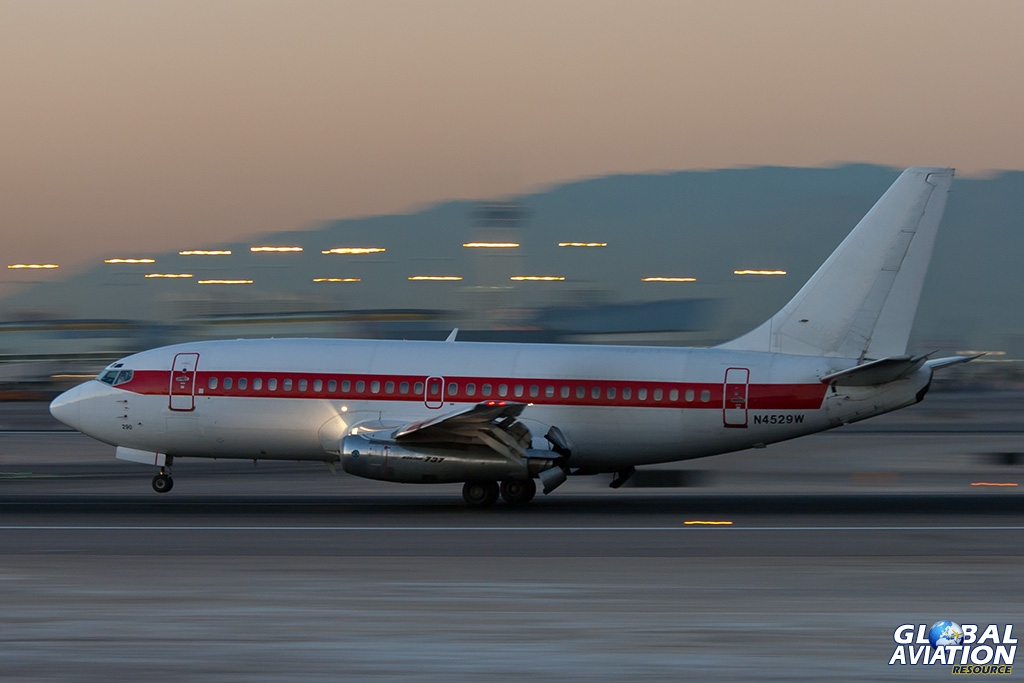
A genuine 737-200 (as opposed to a T-43), N4529W was originally delivered to Pacific Western Airlines in 1973, before being acquired by EG&G in 1983. Retired in 2008 © Paul Filmer – www.globalaviationresource.com

N5175U was another former USAF T-43. Retired in 2009, now stored at AMARG © Scott Rathbone – www.globalaviationresource.com
Today, EG&G has been absorbed into URS Corporation, which has assumed operation of the shuttle service to the NNSS. The current fleet consists of six Boeing 737-600s which were acquired second hand from Air China, with four of the fleet being previously operated by the now defunct China Southwest Airlines. In common with the previous 737-200s, the fleet carries an anonymous but nonetheless distinctive colour scheme, featuring a broad red stripe on a white fuselage and no airline titles. All aircraft are registered to the Department of the Air Force and leased to URS. They carry non-sequential registrations and also feature fleet numbers on the nose.

Fleet number 201, N319BD was formerly operated by the now defunct airline China Southwest Airlines and later passed to Air China. It was acquired by EG&G in 2008 © Paul Dunn – www.globalaviationresource.com

Fleet number 202, N869HH was also delivered to China Southwest (registered B-2156) before passing to Air China. Operated by EG&G since 2008 © Paul Dunn – www.globalaviationresource.com

Fleet number 203, N859WP was formerly B-2160 with China Southwest and subsequently Air China. Passed to EG&G in 2009 © Paul Dunn – www.globalaviationresource.com

Fleet number 204, N273RH was delivered new to Air China as B-5023. Registered to EG&G in March 2009 © Paul Dunn – www.globalaviationresource.com

Fleet number 205, N365SR was formerly B-5027, new to Air China in 2003, joined the fleet in 2009 © Paul Dunn – www.globalaviationresource.com

Fleet number 206, N288DP was the final ex-Air China 737 to be delivered to EG&G; the former B-5037 was delivered in July 2009 © Paul Dunn – www.globalaviationresource.com
In addition to the 737s, the company uses five turboprop aircraft, consisting of two Beech 1900Cs and three King Air B200Cs. These aircraft do not carry the well-known Janet livery, nor do they use the Janet callsign and they do not seem to see such regular use as the 737s.

© Chris Wood – www.globalaviationresource.com

© Karl Drage – www.globalaviationresource.com
Janet operations take place from a dedicated terminal at Las Vegas McCarran Airport; the nondescript building is located on the west side of runways 01/19L/R. From this terminal, a busy schedule operates on weekdays, with around 20 return flights departing for both airfields in the NNSS. The majority of departures apparently head for Groom Lake, with a slightly smaller number bound for Tonopah. Despite this, all the services are flight planned with a destination of “Tonopah Test Range”, and Groom Lake/Area 51 (also apparently known as Homey Airport, KXTA) is never mentioned.

© Paul Dunn – www.globalaviationresource.com
The flights operate to a daily schedule (which can be obtained online from several websites) and, surprisingly, the services can also be tracked by online flight tracking sites such as Flight Aware. Although all flights give Tonopah as the destination, the services to and from Groom Lake can be identified as the ones which consistently arrive ‘early’ – Groom Lake is 83 miles from Las Vegas, Tonopah is 140 miles away. The Groom Lake flights also ‘disappear’ from the map display before reaching their official destination.

© Paul Dunn – www.globalaviationresource.com
Although most of the Janet operations are conducted to Groom Lake and Tonopah, there are a small number of scheduled services to Air Force Plant 42 at Palmdale, CA. Plant 42 is home to the special projects divisions of several aerospace companies, notably Lockheed’s legendary Skunk Works; undoubtedly workers from these organisations are involved in projects being tested in the Nevada desert. The smaller aircraft in the fleet have also been noted at other locations such as Edwards AFB, NAWS China Lake and NAS Point Mugu, all locations involved in aircraft and weapons testing.

Aside from McCarran, Palmdale Regional Airport is one of the very few ‘public’ places where Janet 737s can be seen; N319BD is seen here conducting crew training at PMD in 2011 © Paul Dunn – www.globalaviationresource.com
Probably the most exclusive airline in the world – you certainly can’t buy a ticket to their destinations! – for many (myself included), ‘Janet Airlines’ is a source of fascination. Some airlines and organisations have unusual equipment or colourful schemes. The Janet aircraft are fairly dull looking 737s, but they are interesting for what they represent, rather than what they actually are. They are an intrusion from another world, a highly classified world that doesn’t officially exist, a world of cutting-edge technology and advanced machines, although it is certain that the most interesting projects such as secret aircraft types are a tiny fragment of the work undertaken, hugely outnumbered by much more mundane, but vital, work on weapons systems, countermeasures and the like.

© Paul Dunn – www.globalaviationresource.com
The constant comings and goings of the Janet aircraft at McCarran Airport shows that, although we may never know quite what, something interesting is going on in the desert, and surely some of it will emerge from the ‘Black World’ in the future. Let’s hope so anyway…



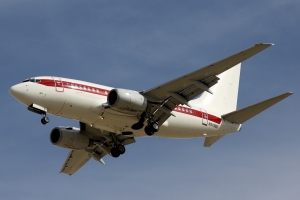























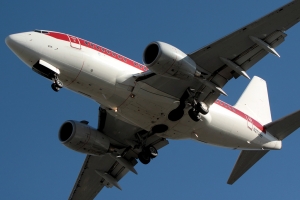
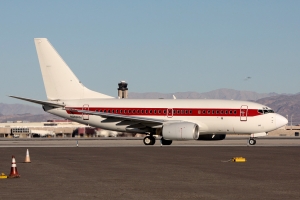

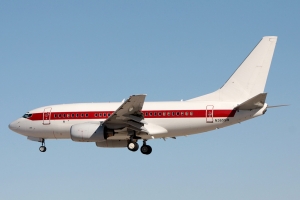








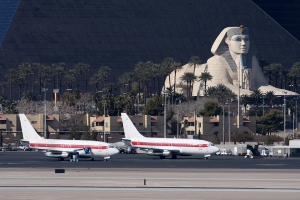






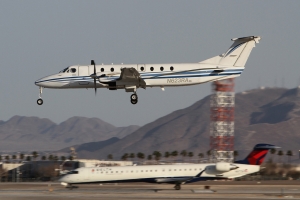
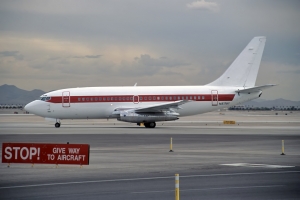





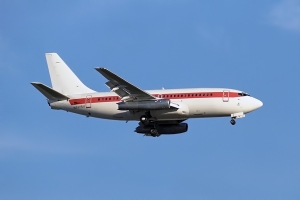





Absolutely fascinating, Paul. Beautifully written, too, with a style that makes me want to read on. Given the limited subjects available, you’ve treated us to quite a variety of photographs (along with the others from KD and co). A couple containing 2 737s I particularly like.